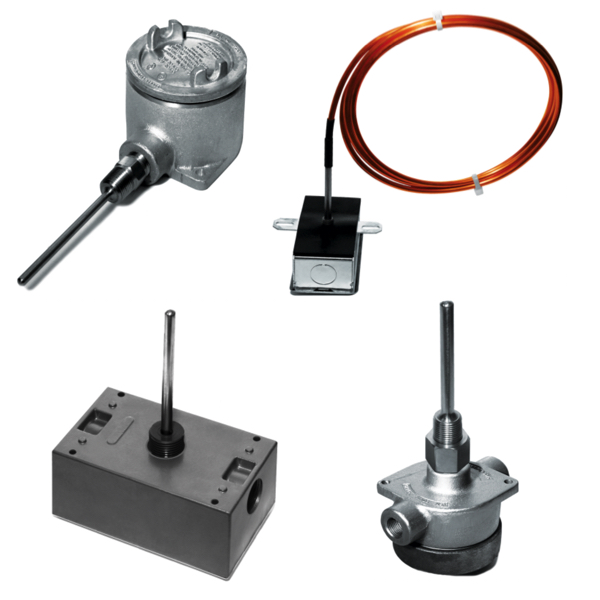RTDs (Resistance Temperature Detectors)

Precision temperature sensors known as Resistance Temperature Detectors (RTDs) derive their accuracy from the correlation of material resistance—most commonly platinum—with temperature. The resistance of an RTD increases as it is heated, following a well-defined curve that makes the sensor very predictable. At the level of construction, an RTD is made with a sensing element that can be either wire-wound or thin-film. Each style has its unique advantages and can be used in different situations. Wire-wound RTDs are very stable and give a very accurate temperature reading over a wide temperature range. Thin-film RTDs are made in a way that allows them to be more compact, and they can be used in situations where space is at a premium.
Resistance temperature detectors (RTDs) are temperature sensors that measure the change in resistance of their sensing element. This element changes resistance in direct proportion to a change in temperature, obeying the fundamental relation of the materials used to constitute the element. If one were to use a standard two-wire configuration to connect an RTD to a measurement device, without compensating for the resistance of the lead wires, the reading from the measuring device would not accurately reflect the resistance of the RTD at the temperature of interest. To avoid this pitfall, manufacturers of RTDs have developed configurations that enable the use of ohmically equivalent lead wires while still providing a precise measurement of temperature.
More Information about Resistance Temperature Detectors
The precise temperature measurement of an application benefits greatly from the reliable and repeatable nature of resistance temperature detectors (RTDs). An RTD's temperature sensing element—for instance, a wire-wound element—ensures that the temperature measurements delivered are accurate and drift very little, if at all, over time. What's more, common calibration practices guarantee that the temperature characteristics of the detector align with those the application requires. Thus, in applications where temperature measurements need to be right on the money and where a sensor's durability and adaptability in different environments are must-have features, an RTD is often the go-to option.
FAQs
What is an RTD and how does it work?
An RTD (Resistance Temperature Detector) is a temperature sensor that measures temperature by detecting changes in electrical resistance as the sensing element’s temperature changes. Most RTDs use platinum elements, such as PT100 or PT1000, because of their excellent stability and repeatability. As temperature increases, the resistance of the RTD increases in a predictable and linear manner, allowing for highly accurate temperature measurement.
What are the advantages of RTDs compared to thermocouples?
RTDs offer higher accuracy, better long-term stability, and superior repeatability compared to most thermocouples. They are ideal for applications requiring precise temperature measurement over a moderate temperature range. While thermocouples handle higher temperatures and faster response times, RTDs are preferred when accuracy and consistency are more important than extreme temperature capability.
What industries commonly use RTDs?
RTDs are widely used in industrial manufacturing, HVAC systems, pharmaceuticals, food and beverage processing, power generation, chemical processing, and laboratories. These industries rely on RTDs for precise temperature control, quality assurance, and regulatory compliance. RTDs are especially common in applications where consistent and repeatable temperature measurement is critical.
How accurate are RTDs?
RTDs are among the most accurate contact temperature sensors available, with typical accuracy ranging from ±0.05°C to ±0.3°C depending on the sensor class and configuration. Accuracy is influenced by lead wire configuration, calibration quality, installation method, and operating environment. Using 3-wire or 4-wire configurations helps minimize measurement errors caused by lead resistance.
Do RTDs require calibration and maintenance?
Yes, RTDs should be periodically calibrated and inspected to maintain measurement accuracy over time. Calibration intervals depend on application requirements and environmental conditions. Routine inspection helps identify sensor drift, wiring issues, or mechanical damage early, ensuring reliable and long-lasting temperature measurement performance.
What is an RTD?
What is an RTD?
RTD stands for Resistance Temperature Detector. RTDs use a specific type of metal that, depending on the resistance measured in the metal, can measure temperature. Thin film element RTDs use a very thin layer of resistive metal adhered to a substrate, typically ceramic, and coated in glass or epoxy. Wire wound element RTDs provide greater accuracy and a wider temperature measurement range, however, over time the element wire can become stressed leading to slight measurement errors. Coiled element RTDs are the most common type of RTD and allow for strain free measurement on the wire element while still providing accurate measurement.
How do RTD elements work?
As the temperature of a metal increases, the metal's resistance to the flow of electricity increases. As the temperature of the RTD resistive element increases, the electrical resistance, measured in ohms, also increases. Each metal has a certain resistance measurement at different temperatures. Based on the resistance that is measured in a given type of metal, it can be determined what the temperature is. The most common types of metals used in RTDs are platinum, nickel and copper.
What are some advantages and disadvantages of RTDs?
RTDs provide a high level of accuracy over a wide operating range. Because of their accuracy, they are often used in situations where temperature measurement is critical. RTDs are rarely used at temperatures above 660 degrees Celsius and they do not provide the same level of accuracy or resolution as thermistors at lower temperatures.

